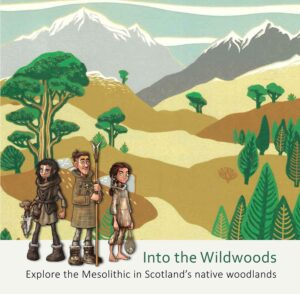
One of the really fun things about my work has been the opportunity to work with artists on reconstructions of the past. Usually, but not always, these have focussed on Mesolithic communities. I’ve been doing it for nearly 40 years, and it has been so interesting trying to bring the world of prehistory to life. I thought it might be interesting to review some of them here. Of course, no reconstruction drawing is ever going to be 100% accurate. They can only ever be used to give an idea of how things might have been. Nevertheless, in their changing styles and information, they provide a wonderful reflection on how my archaeology has changed over the years.
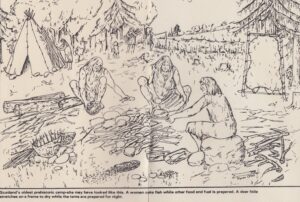
The first image I worked on was a depiction of the Mesolithic site at Kinloch, Rum, drawn for the Glasgow Herald by Marion O’Neil in January 1985. Kinloch got quite a bit of publicity and went on to inspire several images.
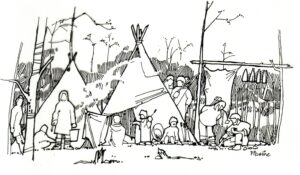
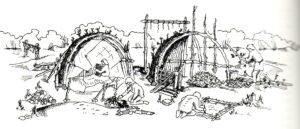
In all of these pictures you can see that people, tasks, and shelters are prominent, though some of the detail is left vague.
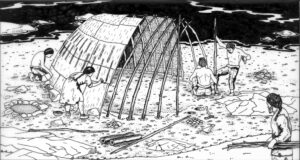
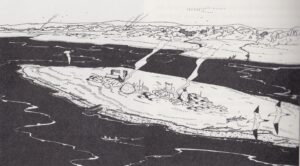
In 1994, Alan Braby drew a series of images for a general publication about Mesolithic Scotland. While many pictures focussed on specific aspects of life and details of settlement, others were much more general landscape views. For the first time, I was thinking about the world inhabited by the Mesolithic communities of Scotland.
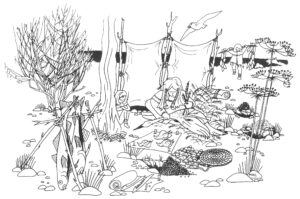
The Mesolithic site at Fife Ness did not offer evidence of a full-blown shelter. In 1998, Mary Kemp Clarke drew this image to focus on the resources and the suggestion that the site had been occupied in the autumn. The nature of individuals is left for the viewer to discern.
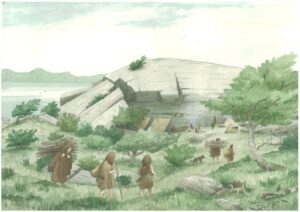
Jump forward to 2006 and Phil Austin completed three images moving from the detailed to a broader landscape view for the Scotland’s First Settlers project which was published as a Scottish Archaeological Internet Report.
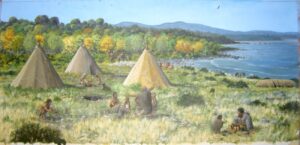
In 2012 I was able to work with Dominic Andrews regarding a Mesolithic Panorama for the displays at the Tomb of Eagles Museum in South Ronaldsay. People, while providing considerable action are less prominent and the overall focus is upon a landscape view, giving a good idea of the world within which the community lived.
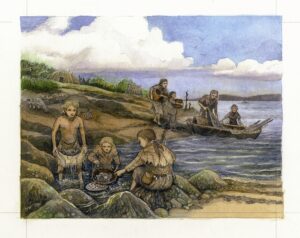
In the same year, Brian Lee worked on images for a Historic Environment Scotland guidebook to Orkney for which I was writing text. He somehow captured both close detail and landscape in his series of images of different periods.
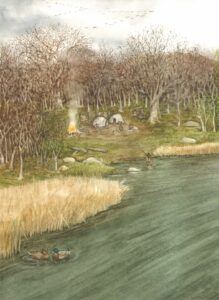
Most recently, I have been working with Jan Dunbar to bring to life the different periods of settlement evidenced by the work of Mesolithic Deeside along the River Dee in Aberdeenshire. The detail here is wonderful, though the settlement itself is well hidden within the landscape. The real star is the river as you will see from the main report. The full results are to be published as another Scottish Archaeological Internet Report.
There are so many things I love about these images. You can see how my focus has shifted from the people to the landscape. You can see how our ideas about clothes have evolved (it is interesting to me that we always depict our characters clothed – there is no direct evidence for this and while the inhabitants of many parts of the globe have gone clothed, there are locations where the wearing of complex costumes was seen as disadvantageous, even in cold climates). I’ve always tried not to be too gender specific in task divisions. And you can see so much about ideas of complexity, sophistication and comfort. In many ways the production of a reconstruction drawing is a minefield, but they make us think, and, in my opinion, the worries are well worth the fun!
You must be logged in to post a comment.